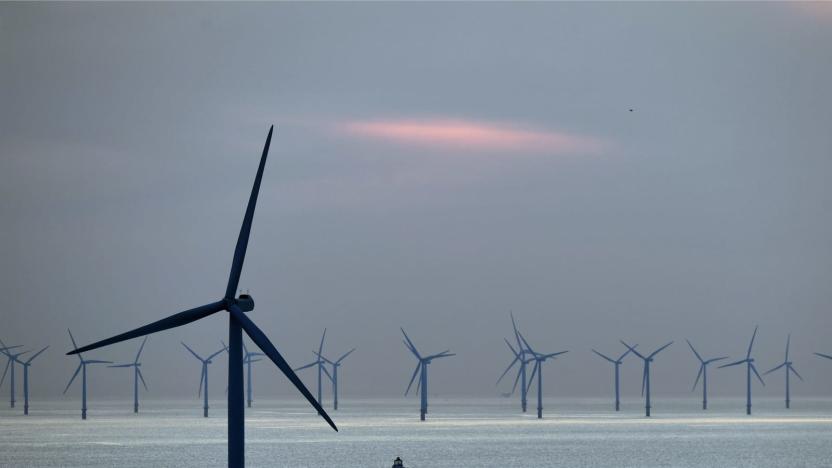fossil fuels
Latest

Only 57 companies produced 80 percent of global carbon dioxide
A new report found that just 57 companies produced 80 percent of carbon dioxide emissions worldwide between 2016 and 2022.

New SEC rules would require companies to disclose climate goals and emissions
Public companies would be required to disclose greenhouse gas emissions they produce under new rules proposed by the US Securities and Exchange Commission.

Wind and solar could meet 85 percent of current US electricity needs
Renewable sources may meet most power demands in 'advanced, industrialized nations,' according to a study.

The UK likely got more power from renewables than fossil fuels last quarter
The UK generated more power from renewable sources than from fossil fuels in the third quarter of 2019. This is the first time that's happened since the UK opened its first public electricity-generating station in 1882. The findings, revealed in an analysis by Carbon Brief, speak to progress the country has made in transforming its electricity system over the past decade.

EU lending bank aims to cut funding for fossil fuel projects by 2020
The European Union has some very long-term environmental goals, but it might not wait around to make some crucial changes. The Guardian has seen proposals from the EU's lender, the European Investment Bank, that would bar funding for any energy infrastructure project that depends on fossil fuels after 2020. EU members counting on funding for gas pipelines and similar projects would have to either scramble for alternative funding next year or reconsider their plans.

America's renewable energy capacity overtakes coal for the first time
America's renewable energy capacity has overtaken coal for the first time ever. According to a report by the Federal Energy Regulatory Commission (FERC), the addition of new solar, wind and hydro capacity in the first four months of the year pushed renewable energy's share of total available installed capacity to 21.56%. Coal's share, meanwhile, has dropped to 21.55 percent, down from 23.04 percent last year.

Rockefeller fund to move its fortune from oil to green tech
If you're in any way familiar with the history of energy, then the name Rockefeller is synonymous with oil. That's why it's such a surprise to learn that the Rockefeller Brothers fund, worth $860 million, has pledged to dump its remaining investments in fossil fuel production over the next five years. The Rockefeller fund is the most notable name in a list of billionaires and funds that have pledged to shift anything up to $50 billion away from coal, oil and gas and into renewable energy as part of the divest-invest movement. It's a timely announcement, too, designed to coincide with the Tuesday's UN summit on climate change, designed to galvanize green activity in the face of the recent, damning, scientific evidence.

Scientists solve solar energy's burning question: how to make it cheaper than fossil fuels
In a fight between solar and fossil fuels, the latter has always had a killer question up its sleeve: "What about supercritical steam?" That's the method by which the most advanced power stations generate electricity, superheating water until it instantly becomes steam, a feat that's only possible (and affordable) by burning coal or gas. Or, at least it was. Australia's Commonwealth Scientific and Industrial Research Organization has managed to use solar energy to the same effect, boiling liquid to temperatures of 570 degrees Celsius in a test chamber. What does this mean for all of us? "Power plants of the future could instead be using the free, zero-emission energy of the sun," explains Dr. Alex Wonhas.

Inhabitat's Week in Green: i-oniq hybrid, spherical solar cell and an incredible LEGO printer
Each week our friends at Inhabitat recap the week's most interesting green developments and clean tech news for us -- it's the Week in Green. This week epic green transportation initiatives kicked off around the world as Inhabitat reported that Shenzhen, China launched the world's largest electric vehicle fleet and London's brand new Eco-Routemaster hybrid bus hit the streets for the first time. We also showcased an earthquake-proof Japanese building system capable of levitating an entire house, and we brought you sneak peeks at the hottest eco vehicles that will be unveiled at next week's Geneva Motor Show, including Hyundai's sexy i-oniq hybrid and Infiniti's Emerg-E plug-in. Audi also turned heads with its souped-up R18 E-Tron Quattro hybrid Le Mans racer, and Perave's 350 MPGe MonoTracer electric motorcycle hit the market.It was also a bright week for renewable energy with a revolutionary spherical solar cell capable of capturing light from all directions, and Austria Solar sending out a "sun-powered" annual report that only appears when exposed to sunlight. Meanwhile, we said goodbye to the polluting energy technology of the past as Midwest utilities shuttered 10 fossil fuel-powered plants and the world's oldest nuclear reactor closed up shop in the UK. Brilliant designers also chased away dark winter days with a sunflower-shaped heliostat that can flood any house with natural light and a cheap, photovoltaic Little Sun lamp for the developing world.Green tech also wired the world in exciting new ways as the Smithonian Institute announced plans to replicate and share its collection with the world using 3D printing tech and a 14-year-old boy invented an incredible LEGO printer. We also watched HP launch an all-in-one workstation that pops open for easy DIY upgrades and repairs, while Huawei unveiled a soaring Pegasus sculpture made from 3,500 smartphones. Last but not least we brought you a look at Google's new Terminator-style augmented vision goggles, and we shared a fun tutorial on geocaching with your children.

Duke study finds solar power cheaper than nuclear, Coach K stronger than Roy
Now, before you get all hot and bothered here, we should warn you that this study only uses information from within the great state of North Carolina (where Duke University is based, obviously), but the results are intriguing regardless. According to new data, the moment we're living in is a crossover one where the declining prices of solar panels may actually make sun-based energy more cost efficient to consider than nuclear. Duke found that the crossover price point was at around 16 cents per kilowatt hour (kWh), and for the first time ever in NC, the cost of one kWh of electricity from solar energy sunk below that. Of course, these results are apt to be even more impressive in sun-rich states like Arizona, Nevada and Utah, but it's fairly clear what the real purpose of the investigation was: convincing the school to shell out for solar panels to energize Krzyzewskiville during week-long campouts for UNC vs. Duke tickets.

Moletech Fuel Saver theoretically saves fuel
Add Moletech to the growing list of companies trying to cash in on going green -- they claim their new Fuel Saver cuts down on emissions and improves fuel economy in all fossil fueled engines. After some preliminary testing the California Environment Engineering Center for Environmental Research seems to agree that the device does actually work, but until more rigorous assessments are made your, uh, mileage may vary. The "universal product" comes in eight models to fit any size vehicle from cars to scooters to boats, with prices ranging from $119 to $299 USD. If you install one in your Prius and start contributing back to the grid, be sure to let us know.







